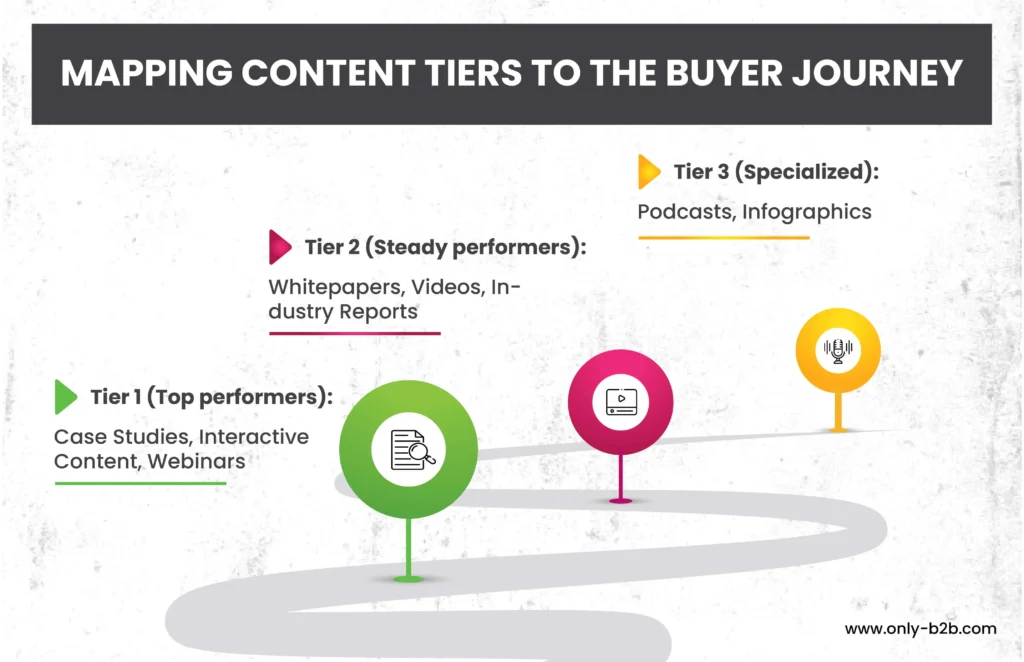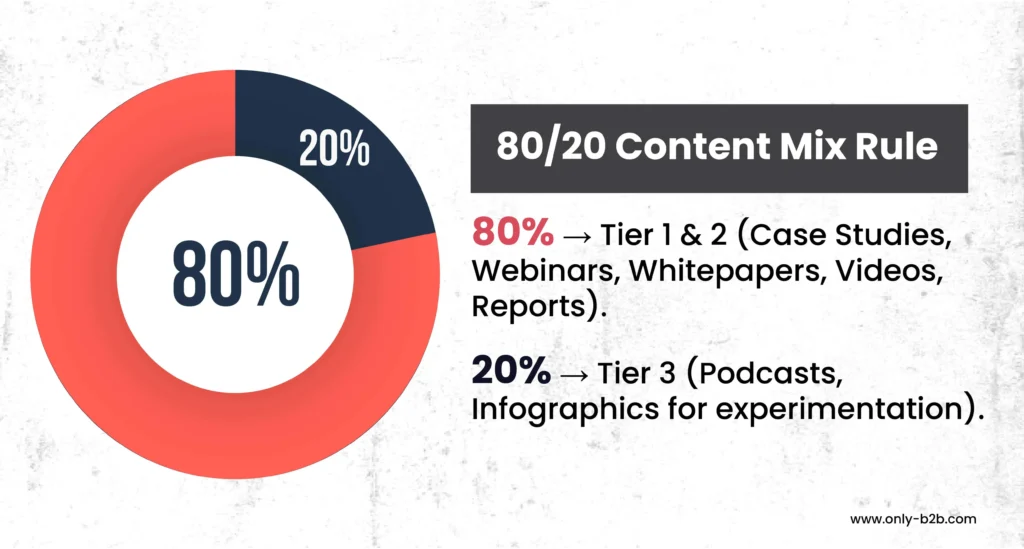B2B organizations collectively pour more than $50 million each year into content syndication. Effective B2B content syndication strategies play a vital role in ensuring that this investment translates into tangible business outcomes.
The intent is clear: greater reach, better leads, and measurable revenue growth.
However, despite this massive investment, the ROI remains disappointing. Over 60% of marketers report that their syndication campaigns deliver only average or below-average results
So, here is a million-dollar question:
I. Why does this disconnect exist?
Table of Contents
- 1 I. Why does this disconnect exist?
- 2 II. The Performance Metrics That Matter
- 3 III. Tier 1: The ROI Champions
- 4 IV. Tier 2: The Reliable Performers
- 5 V. Tier 3: The Specialized Assets
- 6 VI. The Context Factor: Why Rankings Shift
- 7 VII. Building a High-Performance Content Mix
- 8 VIII. Conclusion: Your Performance-First Action Plan
Because syndication is often viewed through the wrong lens, the volume lens. The assumption is simple: the more leads you capture, the more opportunities you create.
But this approach leads to bloated campaigns filled with irrelevant, low-quality leads that clog CRMs, frustrate sales teams, and inflate budgets.
The issue isn’t syndication itself. The real problem lies in the lack of a performance-driven framework that ties spend directly to buyer quality and conversions.
The solution lies in identifying which content formats consistently deliver the strongest ROI and which ones drain your budgets without adding value to the pipeline.
So, what’s the secret content formula? This blog dives exactly into that. By the end, you’ll know which formats to prioritize, where to invest. Please read on.
II. The Performance Metrics That Matter
Moving from guesswork to precision tracking the right metrics is the first step. For too long, marketers have celebrated vanity numbers such as downloads or impressions. But these pretty figures have little correlation with revenue.
A lead quality score provides more clarity. It assigns a score on a 1–10 scale based on:
- ICP Fit → How closely the lead matches your Ideal Customer Profile.
- Engagement Depth → How actively the prospect interacts with your content.
- Funnel Progression → How far the lead has moved in the buyer’s journey.
When this metric is ignored, you end up overvaluing one-off clicks that never mature into opportunities.
Cost per Qualified Lead (CPQL)
Cheap leads are rarely good leads, aren’t they?
While many campaigns focus on CPL (Cost Per Lead), it often creates a false sense of efficiency by prioritizing quantity over quality.
CPQL (Cost Per Qualified Lead) solves this by showing you the true cost of acquiring prospects who:
- Match your target persona
- Demonstrate genuine buying intent
Engagement Depth
More clicks, more form fills, and more whitepaper downloads don’t always mean better leads. That’s the surface-level reality, and it can be misleading.
To seek reality, you must dig deeper. Track meaningful interactions such as:
- Spending 5 minutes in an interactive ROI calculator
- Attending a 30-minute webinar
By measuring these deeper signals, marketers can prioritize leads showing readiness rather than just curiosity.

III. Tier 1: The ROI Champions
Some content formats consistently outperform others when it comes to syndication.They generate higher-quality leads, convert faster, and show up in attribution reports tied directly to revenue.
Case Studies
Case studies are the undisputed leaders, delivering conversion rates hovering around 3.2%, compared to the broader B2B average of 1.8%.
They provide a living manifesto of measurable results that no pitch deck can replicate. Buyers want proof and confidence, and they get it by seeing outcomes from peers in the same industry.
However, burying case studies on your website limits their potential. When repurposed into syndicated campaigns, especially tailored to industry or region, they become magnets for decision-makers who are already comparing options. Leveraging content syndication platforms amplifies this reach even further, ensuring your case studies land in front of the right audience at scale.
Interactive Content
Interactive content is another rising star in the syndication space, including ROI calculators, assessments, and dynamic infographics.
Isn’t designing interactive tools, setting up dynamic workflows, and integrating data capture too much effort? But what if we tell you they hold attention up to four times longer than static PDFs while capturing intent data that boosts lead scoring accuracy.
Surely, the payoff is worth it: high-quality leads with stronger signals of readiness.
Webinars
Webinars continue to dominate despite “content fatigue.” They boost SQL conversion rates as high as 23%, far better than most other syndicated assets.
Their success comes from combining thought leadership with interactivity.
Including a live Q&A session builds authority and filters out passive attendees, leaving you with engaged, high-intent prospects.
And no, webinars are not just top-of-funnel tools. In fact, late-stage buyers often attend webinars to validate purchasing decisions, making them equally effective for awareness and conversion.
IV. Tier 2: The Reliable Performers
Whitepapers
Whitepapers will never go out of style when positioned correctly. Surely they may not be the flashiest assets, but they provide depth, credibility, and value, especially during the consideration stage.
To increase their effectiveness, back them with original research or third-party validation.
Video Content
Short explainers, demos, and testimonials are a great way to humanize the message while simplifying complex value propositions. Yes, production costs are higher, but the returns justify the investment.
Personalized explainers, demos, and testimonials drive significantly stronger engagement and deeper buyer connections, especially when videos are tailored to industry-specific challenges.
Industry Reports
When co-branded with analyst firms or research partners, industry reports carry authority that syndicated blogs or guides often lack.
These reports shine during awareness campaigns, especially among executive buyers who equate research-backed insights with trustworthiness.
V. Tier 3: The Specialized Assets
Podcasts
Podcasts are a great way to build strong brand equity and thought leadership. True, they don’t deliver instant ROI, but yes, they are great for nurturing and relationship-building, something no other content format delivers.
Infographics
Infographics deliver snackable insights that are easy to consume and share, but they lack the depth required for qualification.
But when paired with higher-value assets, they can increase reach and engagement. They work best as supporting players, so don’t treat them as stand-alone syndication drivers.
VI. The Context Factor: Why Rankings Shift
Ranking isn’t absolute, like a relay race. The winner depends on who is running and at which stage. This means effectiveness shifts dramatically depending on industry, buyer maturity, and timing.
Effectiveness varies dramatically depending on:
Industry
- In compliance-heavy sectors like healthcare or finance, whitepapers and analyst reports perform better.
- In fast-moving industries like SaaS, interactive content and webinars dominate.
Audience Maturity
- Early-stage buyers prefer educational reports or industry benchmarks.
- Later-stage prospects seek ROI-driven tools or peer validation through case studies.
Timing
- ROI calculators and financial case studies see higher engagement toward the end of fiscal years when budgeting decisions peak.
- There is no universal content ranking. Effectiveness depends on your audience’s journey, maturity, and timing.
VII. Building a High-Performance Content Mix
High-performing marketers have figured out patterns based on experimental formats, following the 80/20 rule.
- Allocate the majority of resources to Tier 1 and Tier 2 content.
- Reserve a smaller share for Tier 3 experimentation.
This balance avoids the pitfall of chasing novelty while still leaving room for innovation.

So, how do you allocate resources? Use the effort-versus-return approach.
High-effort assets like webinars and interactive tools deserve the lion’s share of focus because of their proven ROI impact.
Lighter assets like infographics or podcasts should be treated as supplements that expand reach rather than primary conversion drivers.
However, everything surely boils down to iteration.
Test headlines, creative formats, and distribution channels regularly. Measure CPQL and engagement depth across campaigns.
This way, you make sure optimization decisions are based on evidence rather than assumptions.
VIII. Conclusion: Your Performance-First Action Plan
If you’ve made it this far, content syndication should no longer feel like a gamble.
The volume-first mindset has already cost marketers millions in wasted spend, but it doesn’t have to anymore.
The future lies in performance-first strategies that prioritize quality, track meaningful engagement, and rank assets based on real-world ROI.
So, your immediate steps:
- Lead with case studies, interactive content, and webinars.
- Use whitepapers, videos, and reports as supporting anchors in the funnel.
- Deploy podcasts and infographics strategically to amplify reach.
- Measure success through lead quality, CPQL, and engagement depth, not vanity metrics.
When done well, syndication evolves from a cost center into one of the most accountable, ROI-driven engines in B2B marketing.
If you’re ready to shift your content syndication from average to exceptional, the next logical step is a custom content performance audit, a roadmap that pinpoints exactly which assets deserve investment and which ones are quietly eroding ROI.

Vikas Bhatt is the Co-Founder of ONLY B2B, a premium B2B lead generation company that specializes in helping businesses achieve their growth objectives through targeted marketing & sales campaigns. With 10+ years of experience in the industry, Vikas has a deep understanding of the challenges faced by businesses today and has developed a unique approach to lead generation that has helped clients across a range of industries around the globe. As a thought leader in the B2B marketing community, ONLY B2B specializes in demand generation, content syndication, database services and more.





